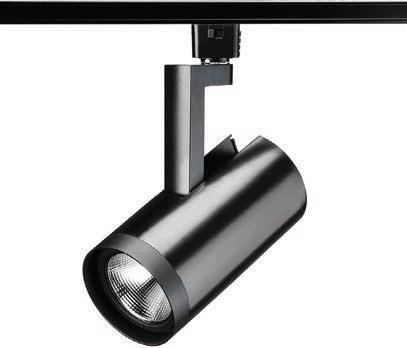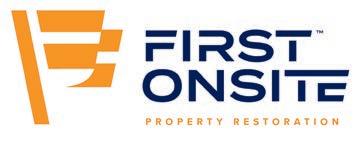
11 minute read
BRIGHT IDEAS
from CFMD April 2021
by MediaEdge
From grand, celestial-inspired pendants to miniature lights on ultra-thin track rails, the latest round of LEDs offers a wide variety of applications for various types of spaces.
Quadrant by Eureka features a glowing sphere and interlocking felted panels that reduce ambient noise. Designed for open areas or rooms where the surface material of the floor, walls, and ceiling reflect sound, it is o ered in heights of 23, 35 or 47 inches. Standard colours are charcoal or silver grey, and the shade is also available in a wide array of premium colours for mixing, matching and dynamic arrangements. A highperformance LED module is mounted on an extruded aluminum heatsink, with many control options available.
SONNEMAN–A Way of Light its celestial-inspired Constellation line with scalable fixtures like Hedron LED Pendant. The globelike composition of radiant LED hubs connected by the structural tension of minimal coaxial rods creates the appearance of a floating celestial body above a table or display. At a height of 45.75 inches and 45 inches in diameter it is available in Satin Nickel with White Optical Acrylic shades or Polished Black Nickel with Clear Faceted Acrylic shades.



Pista, a configurable product by Modular Lighting Instruments, showcases slimmer magnetic track rails, miniature light fixtures, and ultra-thin suspension cables. Designers can play with di erent modules on single or multiple track rails in di erent lengths, light e ects, and colours. Available in a variety of new LED modules, it features suspended and recessed profiles, in either a black or white structure.

Lance by Meteor Lighting is a new range of direct and indirect wall luminaires designed for facility exteriors. Available in four and six-inch apertures, it o ers uniform shielded light that creates strong visual rhythm within a space, and enlivens a variety of outdoor facades. Lance delivers a lumen package range of 1,620 lm to 10,000 lm mixed with RGBW colour changing compatibility.
Hollowcore by Luminis is a modern take on a classic shape, suitable for both traditional high bay applications and more contemporary spaces. With a circular LED light engine and an open centre concept, Hollowcore is designed to optimize and deliver light evenly and where needed. It delivers up to 13,000 lumens of uniform light with a batwing distribution for minimal cave e ect. Available in a range of colour temperatures from 2700K to 4000K, it can be installed in open areas to illuminate lower building levels.

ENVEX™ Series from Lithonia Lighting is a high-performance recessed ambient luminaire designed to meet intense specifi cation requirements with ease. The timeless look fi ts in any space without distracting from the beauty of the architecture. ENVEX is available in two designs, both o ering volumetric distribution. Each fully-luminous design is visually comfortable for occupants, and ideal for o ces, schools and healthcare. Juno welcomes new lumen packages to its Trac-
Lites™ family. The R610L and R612L Integral Driver LED Cylinder track fi xtures come in 2200 lumens and 3300 lumens, while consuming only 21 watts and 37 watts, respectively. Suited for retail, hospitality, and commercial settings, each fi xture can be specifi ed with a variety of CCTs, CRIs, and beam distributions. It comes with a nested yoke arm for straight-down aiming and deep source regression to maximize glare control.

A brand new day for FIRST ONSITE

With decades of experience in the fi eld, FirstOnSite Restoration is taking the next step. On March 29, the disaster restoration specialist united its eight sister companies from Canada, the U.S., and Puerto Rico under the singular and evolved FIRST ONSITE name and brand.
“FIRST ONSITE is looking to redefi ne the industry with its unwavering mission to be the fi rst to help, support and lead in the face of disaster,” said Dave Demos, Chief Executive Offi cer of FIRST ONSITE, Canada. “This shared promise aligns our collective efforts and positions us to be the only restoration partner Canadian businesses and homeowners will ever need.”
For more on this industry rebranding, and what it will bring to the property management community, we reached out to Janine Yetke, Canadian Director of Marketing for First Onsite Property Restoration. This is a big move for FIRST ONSITE. It is. And we’ve been looking forward to it for a while. Until now, we’ve been operating under several names, including Quebec’s Restauration PremièreAction, Interstate Restoration, Interstate Hawaii, Trilink Restoration Services, Super Restoration, CATCO, Rolyn and Perfection Property Restoration. Now, we’re going to be known solely as FIRST ONSITE, which will help us form greater cohesion between our 80-plus branches and position the company as one North American force in property restoration. What was the motivation to rebrand? We’re constantly moving forward as a company and looking for ways to be a stronger restoration partner for our clients. Our brand promise, which we strive to live by, is to be the only partner our clients will ever need. The brand journey we’ve been living for many months continues on as our teams come together under our shared promise. This North American rebrand helps form the foundation for a common operating platform that delivers greater consistency and effi ciency between our 2,200-plus team members and for everything we do. Why is that consistency of service important? We work with a lot of multinational companies that have multiple properties under their portfolio. If they’re working with us, they want to know we’re providing the same project management experience, reporting experience, and onsite responses from one site to the next – even if it’s across the country or the continent. So, it’s the ability to be more consistent in our responses, and draw on the full resources of our company that makes a difference for our clients.

Can you give us an example of that consistency in action? One of the best examples is our recent work in Texas during the polar vortex storm. This was a huge disaster event with a lot of property and infrastructure damage that required quick and decisive actions. This was an example where having a massive North American network to draw from was very helpful in dealing with that situation. We were able to tap into the full breadth of our people, equipment, and resources to deal with those problems and show our clients the value of having all our brands coming together to make it happen.
Similarly, when our Canadian clients suffer losses, they know that we can mobilize anywhere, anytime, and in the case of catastrophes like the wildfi re and fl ooding events in Fort McMurray, with incredible scale. Having a consistent approach, and access to resources and teams across North America provides peace of mind to our clients when they are facing distressing situations. What’s next for FIRST ONSITE? We are constantly seeking new ways to bring more value to our clients. One of the areas we’re really investing in is the area of preparedness and property resilience, which means working with clients to design and implement emergency preparedness plans so they know exactly how to respond when they’re hit with a disaster and exactly how we’re going to support them every step of the way.
We’re also intent on drawing on the depth of expertise within our various industry specialties to meet clients’ unique needs. Besides our scale to handle large jobs and mobilize massive amounts of resources, we have regional expertise in various specialties. With our one company approach, we’re working closely to learn and share skills among our teams. That approach, combined with our local knowledge, allows us to serve our key commercial clients in all asset classes, especially those supporting critical businesses in our communities. So, it’s looking for opportunities like this within our growing network to share perspectives and best practices.

FIRST ONSITE [www.fi rstonsite.ca] is a leader in disaster remediation, property restoration and reconstruction services, helping North America Restore, Rebuild, and Rise after catastrophic events of every kind. Learn more about the FIRST ONSITE rebranding at becomingfi rstonsite.com.
BY THOMAS MUELLER
RETROFIT REMEDY
Canada has set its sights on significant carbon reductions by 2030 and complete decarbonization by 2050. Such ambitious goals will no doubt change how Canadians live, work and get around. As a result, the transition to a low-carbon economy creates apprehension in some, but in others, it drives anticipation of the potential for innovation and economic growth.
Canada’s building sector has the potential to benefit from such a shift. Today, buildings account for about 30 per cent of Canada’s carbon emissions when building operations, construction and materials are considered. It ranks among the top sectors for carbon emissions reduction and as such, is a significant target for policy makers and, increasingly, investors through sustainable finance mechanisms. Over the years, many reports have shown that buildings represent the low hanging fruit when it comes to carbon emissions and it is the only sector where improvements go hand in hand with positive returns on investment.
However, new green building construction alone won’t deliver on Canada’s 2030 greenhouse gas (GHG) reduction targets. CaGBC research found that national targets can only be reached if the emissions from the large existing institutional, commercial, and multi-residential buildings are reduced at scale. While builders and developers are increasingly adopting green building approaches, owners and managers are not yet broadly retrofitting existing properties at a level that would yield meaningful carbon emissions reductions. Increasing the scope, scale, and speed of improving the carbon performance of existing buildings is crucial.
To slash building sector GHG emissions by 17 per cent below 2005 levels, Canada would have to have constructed all new large buildings to zero carbon performance starting in 2017 and through to 2030. In the same time frame, the industry could capture a maximum 51 per cent reduction by retrofitting existing buildings to low carbon.
SMART INVESTMENTS
As pressures to meet mandated carbon targets by 2030 and 2050 increase, the cost of inaction will continue to grow. The Supreme Court ruled in favour of the federal government’s carbon pricing plan on March 25, which will increase the price of carbon to $50 per tonne in 2022 and $170 by 2030. Further, every new building that is not built to zero carbon today will inevitably require major investments to upgrade its mechanical equipment, ventilation system, and potentially building envelope in the next 30 years.
With the right market signals and incentives, Canada can create a retro t economy now that would yield skilled jobs for the Canadian economy, operational savings from energy and carbon reduction and better, healthier buildings for Canadians. The recent allocation of $2 billion from the Canada Infrastructure Bank for building retrofits, for example, provides a pathway for financing large scale renewal of existing buildings. Industry-trusted standards, methodologies, and certification will have to come into play to verify performance and ensure we are making progress.
Tools such as the Investor Con dence Project (ICP), and its Investor Ready Energy E ciency (IREE) certi cation are helping secure nancing to support much-needed energy e ciency upgrades. ICP provides a global underwriting standard for the evaluation of energy e ciency retro t projects, with the IREE certi cation providing a thirdparty assessment that gives investors the con dence that energy savings will materialize. Projects such as E ciency Capital’s retrofit of WoodGreen Community Housing show how innovative investment approaches can fund much-needed improvements to unlock utility and carbon savings.
ZERO CARBON CLOSER THAN PRESUMED
While relatively new in the market, the Zero Carbon Building Standard has received tremendous interest as the building sector looks for ways to eliminate carbon. The standard applies to new and existing buildings and balances the rigour required to ensure zero carbon performance with the exibility needed to encourage widespread adoption. As a result, a variety of building types and sizes target and achieve zero carbon — from o ce towers to re halls and warehouses — across the country. Such divergent projects prove that zero carbon is within reach for existing buildings.
Green building continues to advance new solutions and drive innovation to create the low carbon building stock needed in the future. However, it is the owners and operators of existing buildings and investors that will ultimately have the most signi cant impact on whether Canada will meet its carbon reduction targets. Reduction of carbon emissions of 30 per cent or more across entire portfolios are required. Owners are well
Thomas Mueller is the president and CEO of Canada Green Building Council.
9 24/7 Relief Services 9 Janitorial Services 9 Live In/Out
SuperIntendent Services 9 Commercial/Residential
Cleaning 9 Office Cleaning 9 Much More






